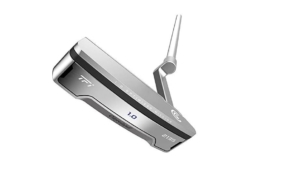Double Wide Putter Vs Blade – What’s The Best Option For My Game?

When I started playing golf, I owned a thin-bladed Spalding Cash putter. Over the years, golfers around me began carrying oversized mallet heads.
I was never a fan of them until I saw a double-wide putter.
Ever since, I have been debating what is best between a double wide putter vs blade.
This post aims to cover the pros and cons of each design to assist you in finding the ideal putter for your game.
Double Wide Vs Blade Putters Overview
If you talk to any golfer who started playing before the 1990s they will tell you that a blade putter was typically the only option.
While I learned to putt with a blade and still feel most comfortable with it, I acknowledge that it is less forgiving than a mallet.
The same concept with irons and drivers applies to putters. Those with thinner, compact head shapes like blades offer less surface space for error.
The oversized construction of a mallet head increases MOI for optimal forgiveness. That leads to consistent top-spin and stroke control to improve your strokes gained putting percentage.
Golf Magazine’s Andrew Tursky confirms this theory by suggesting that 60% of the top 50 putters on tour use a mallet putter design.
What Is A Double Wide Putter?

According to Tursky, a double-wide putter features the design of a classic bladed flat stick.
But it is larger and heavier and offers extra forgiveness on off-centre strokes. In essence, a double-wide putter has the face of a blade and the back of a semi-mallet.
What Are The Advantages
Forgiveness
The stand out advantage of a double-wide putter is the forgiveness that it affords you. Thanks to additional weight in the head, the putter possesses optimal MOI, which delivers forgiveness and a consistent roll. Even on off-centre strikes
Stroke Consistency
The additional weight of double wide putters helps you develop a smooth, consistent stroke that improves your distance control and accuracy. It is a design that is ideal for those of you who stab at your putts and need the extra weight to help you develop a rhythmic stroke.
Alignment Aid
Thanks to the wider construction of these putters, engineers can fit them with superior alignment aids. It helps us ensure that we are aiming along the desired line. As a result, we start our ball on the correct line improving the accuracy of our read.
Reduced Twist
As a result of the additional weight of a double-wide putter, it resists twisting through your stroke. That leads to a squarer face at impact, which helps you start your ball on the desired line.
Accuracy
The final advantage of double wide putters is the increased accuracy they deliver. Thanks to a consistent stroke and improved line read’s, it is more likely to produce improved accuracy over a blade putter.
What Are The Disadvantages
Oversized Head
Although the face of a double-wide putter resembles a blade, its chunky appearance rears its head when you stand over the ball. While this does not bother many of us average golfers, it won’t appeal to traditionalists.
Expensive
Since double-wide putters contain additional technology, they tend to fetch a higher price tag.
Feel
The additional weight of a double-wide putter head reduces the feedback at impact, which superior players may desire.
What Is A Blade Putter

Golf WRX’s Gianni Magliocco describes a blade putter as a heavily toe-weighted traditional design.
He further states that engineers position the sweet spot towards the heel. A blade is the thinnest putter construction on the market, offering reduced forgiveness and an exceptional feel.
What Are The Advantages
Feel
The lighter construction of a blade putter leads to a superior feel and feedback at impact. Some players prefer excessive feedback, as it helps them control the weight of their stroke for improved distance control.
Affordable
Thanks to their simple design, and limited use of groundbreaking technology, blade putters are generally a more affordable alternative to double-wide putters.
Clean Design
What you lose in forgiveness with a blade putter is made up for in appearance. The simple flat blade design is clean and appealing to traditionalists.
Distance Control On Longer Putts
According to Arc Golf USA, the reduced weight of blade putters often makes it easier to control the distance on longer putts.
With the lack of feel and additional weight of heavier double-wide putters, you can get the distance control wrong and send the ball yards past the cup.
Arc Stroke
Magliocco explains that the heel-positioned sweet spot is best suited to players with an Arc stroke.
The pendulum type motion helps you keep your face square to connect the ball in the target zone for optimal roll and accuracy.
What Are The Disadvantages
Reduced Forgiveness
The main downside of blade putters is the reduced forgiveness that they offer you. Its light, compact design leads to a smaller sweet spot that requires precision.
If you strike the ball off-centre, you will experience an erratic roll and inaccuracy compared to a mallet.
Best Double Wide Putter – Mini Review With Pros And Cons
Odyssey Stroke Lab Triple Track

Odyssey’s Triple Track putter provides superior alignment assistance thanks to Vernier Hyper Acuity (VHA).
VHA analyzes how we see straight lines to help us improve our ability to read the line.
Added to its alignment features is the presence of a micro hinge star insert that produces consistent roll and feel, even on off-centre strikes.
If you struggle to read the line of your putts, the advanced triple track aid may benefit your cause.
Pros and Cons
Pros
- Exceptional alignment aid
- Increased MOI
- Produces consistent roll even on off-centre strikes
- Smooth feel
- Improved accuracy
Cons
- The oversized head does not appeal to traditionalists
- Moderately expensive
Overall Score: 96/100
Check Out More Reviews:
Best Blade Putter – Mini Review With Pros And Cons
Cleveland TFi 2135 Satin 1.0

The Cleveland TFi 2135 Satin offers you the construction of a classic blade with the mallet’s performance features.
By employing 2135 technology, the engineers raised the alignment to help you identify when your ball is in line with the centre of the face.
Besides the enhanced alignment feature, the TFi Satin 1.0 features an optimally milled face to deliver a consistent roll. Plus, a TPU Face insert works to provide superb acoustics and feel.
Overall, the Cleveland TFi 2135 Satin 1.0 putter is an affordable option for those of you who prefer the classic, clean look of a blade.
Pros and Cons
Pros
- Optimal feel
- Consistent roll
- Advanced alignment feature
- Affordable
- Clean look
Cons
- Reduced forgiveness
- It is more challenging to judge the speed of your putt compared to a mallet putter.
Overall Score: 94/100
Check Out More Reviews:
Conclusion on Double Wide Putter vs Blade

There you have our review on a double-wide putter vs blade. As we saw, the former provides optimal forgiveness, alignment and reduced twist.
Conversely, a blade is less forgiving. But, it is affordable, rocks an appealing design and produces a superb feel.
Overall, a double-wide putter is better suited to the average golfer, who demands forgiveness and consistency. It is for this reason that beats the blade as my superior pick.
If you are looking for a forgiving putter, offers consistency and resists twisting, you can take a look at the Odyssey Stroke Lab Triple Track here.

